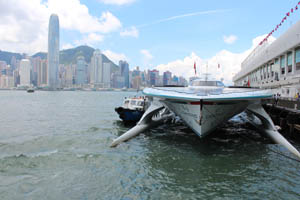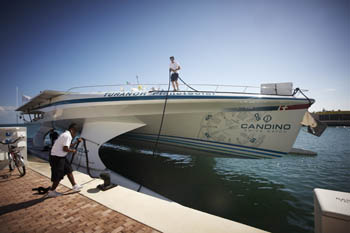PlanetSolar arrived in Hong Kong yesterday on day 319 of its 18-month world circumnavigation challenge, powered by solar energy, having set out from Monaco on 27 September 2010.
The enormous double-hulled boat is circumnavigating the globe under a Swiss flag and measures close to 102 feet in length and 50 feet in width.
Under the direction of its four-man crew, the boat has already successfully traversed the Atlantic Ocean, the Panama Canal, the Pacific Ocean, docking in cities such as Miami, Cancun, Manila, Brisbane and now Hong Kong, as well as places such as Tonga, New Caledonia and the Galapagos Islands.
Using the latest in solar photovoltaic technologies and materials, the aim of the team behind the TÛRANOR PlanetSolar catamaran is to achieve the first circumnavigation of the world on a solar-powered boat, as well as demonstrating that high-performance solar mobilityon water is possible.
Back at the start of the boat’s solar trip, entrepreneur and owner of the TÛRANOR PlanetSolar, Immo Ströher, said: “We are on our way to demonstrate that motorised shipping can work without fuel.”
TÛRANOR gets its name from J.R.R. Tolkien’s Lord of the Rings and translates as ‘the power of the sun’ and ‘victory’.
The boat itself has already set two records: fastest crossing of the Atlantic Ocean by solar boat and longest distance ever covered by a solar electric vehicle.
The boat is now aiming to reach China/Shanghai (August 2011); Singapore (October 2011); India/Mumbai (November 2011); Emirates/Abu Dhabi (December 2011); and Transit Suez (February 2012) before crossing the Mediterranean to complete its voyage and finally rest in Monaco in April 2012.
The biggest partners of the expedition are the Swiss watch producer Candino, the energy management company Immosolar, SunPower and the Swiss Confederation. PlanetSolar falls back on technical data from Metéo France for circumnavigating the world. PlanetSolar’s project base is in Yverdon, canton of Vaud, in western Switzerland.
So here’s a taste of the boat’s solar features:
- Solar panels from Solon AG in Berlin are installed on deck using solar cells, supplied by the Californian solar energy giant SunPower. A total of 825 modules, equipped with 38,000 individual photovoltaic cells, cover a total surface area of 537 sq metres (including side riggers and rear wings).
- These solar cells capture energy, which is then stored in six blocks containing 12 batteries each – 648 cells use maintenance-free lithium-ion technology from GAIA in Nordhausen. Each of the six blocks weighs less than two tonnes.
- The boat comprises 20.6 tonnes of carbon fibre and 11.5 tonnes of foam core.
- 23 tonnes of resin and hardener were used by the Kiel-based boat-building firm Knierim Yachtbau to create the boat.
- It is driven by two contra-rotating carbon propellers from Voith Turbo Marine Composite Technology GmbH.
- Four electric motors from Nuremberg – two per drive shaft – have a maximum output of 120 kW and an energy efficiency of more than 90pc, according to the crew.
- The PlanetSolar crew is using a “sun route software and forecast system”, which is giving them information on the expected weather, wave height, clouds and sun intensity.
S-mobility
According to the team, the main challenges during the trip are energy management and efficiency. They say s-mobility (smart and solar mobility) only makes sense if the costs are competitive, which is why the boat uses materials and technology available today which have the potential to be mass produced.
SolarVillage demonstration
The crew are also carrying a SolarVillage demonstration around with them, so when they dock they set up displays for people to learn more about solar energy. Some of the solar snacks on offer for people to interact with include remote control solar-powered boats and simulators, as well as exhibitions relating to renewable energy.
Dodging rebels in the Pacific
Before stopping in Manila in the Philippines on 20 July, the PlanetSolar crew also had to be careful with rebel situations in the south of the Philippines and were forced to take a couple of detours in order to stave off potential invaders. SunPower solar cells are produced in one of its largest factories located close to Manila.
Speaking in July from Manila, the founder and co-skipper of PlanetSolar, Raphaël Domjan, said the crew was pleased that PlanetSolar crew passed the first pirate test successfully, demonstrating that their journey is safe both technically and tactically.
“We have successfully covered more than 35,000 kilometres, and we are looking forward to also reaching the Asian countries with our important message. Today, we can proudly say that we have a project which mastered the longest distance ever with only the help of the sun, and that alone is worth a lot,” said Domjan at the time.
By the time the boat departed from Cairns, Australia in June, PlanetSolar had crossed the equator a second time and mastered the change from the winter in the southern hemisphere to the summer in the Northern hemisphere.

PlanetSolar, pictured in Brisbane in May, Image courtesy of PlanetSolar
Solar Relay for Hope – Brisbane
When the boat crossed the Pacific to reach Brisbane on 30 May, 175 young Australians launched PlanetSolar Relay for Hope, a relay from one landing stage to the next, in which people present their visions and hopes for a solar-energy driven world.
Brisbane was chosen to officially launch the Solar Relay for Hope because of the massive natural disasters that occurred at the beginning of 2011.
Reaching the Australian continent marked a special turning point for PlanetSolar as it represented half-time in its 18 months of circumnavigation.
PlanetSolar arriving in Brisbane Australia
Video courtesy of PlanetSolar Youtube channel
New Caledonia
PlanetSolar reached New Caledonia on 16 May 2011 and had a crew changeover there. By that stage, the TÛRANOR PlanetSolar has set two records: fastest crossing of the Atlantic Ocean by solar boat and longest distance ever covered by a solar electric vehicle.
More than half of the distance (15.000 nautical miles) had been covered powered solely by solar energy at the time.
Solar arrived at Tonga’s capital Nuku’alofa on 29 April where the crew met Tonga’s prime minister followed by a PlanetSolar presentation at Tonga’s first Sustainable Energy Expo.
The boat was forced to change its route on 30 March and return to Bora Bora due to mechanical problems in the steering system of the propeller blades.
It reached Papeete in Tahiti on 22 March 2011.

PlanetSolar approaches French Polynesia in March. Copyright © 2011 Pierre Lesage
The boat docked at the port of Nuku Hiva on the Marquesas Islands in French Polynesia on 4 March 2011, having successfully crossed the Pacific.
Exceeding the limits of solar mobility
On 22 February, PlanetSolar reached Humboldt Current, named after the German naturalist and explorer Alexander von Humboldt and one of the major marine ecosystems in the world.
When it reached Humboldt Current, TÛRANOR PlanetSolar had covered the longest track ever travelled by a solar electric vehicle. Since 2004, this record had been kept by the solar car of the Midnight Sun Solar Race Team, which travelled a distance of 1,070 kilometres through Canada and the US.
The boat docked on the Galápagos Islands on 25 January 2011.
PlanetSolar successfully passed through the Panama Channel from East to West in late January 2011 – becoming the first solar boat to achieve such a feat.
2010 timeline
– PlanetSolar arrived in Cartagena, Columbia on 19 December 2010.

PlanetSolar crew anchor the boat in Cancun during the UN climate change convention in December 2010
– The boat docked in Cancún, Mexico, during the Unted Nations Framework Convention on Climate Change in early December 2010.
– It reached Miami, Florida, on 27 November 2010.
– The boat completed a successful transatlantic crossing on 18 November 2010, stopping briefly in St Marteen in the Caribbean to register the fastest transatlantic crossing of a solar boat yet.
– On 22 October, the boat left Las Palmas on the Canary Islands after a four-day stopover.
Main photo: TÛRANOR PlanetSolar crew members rest aboard the solar powered boat, after it reached Hong Kong on 15 August 2011. Image courtesy of PlanetSolar